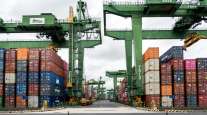Trade Deficit Widens to Four-Month High as Exports Decline

The trade deficit in the U.S. widened in September as exports cooled from a record, highlighting how weakening global growth will affect the world’s largest economy.
The gap grew by 7.6% to $43 billion, the largest since May, from $40 billion in August, Commerce Department figures showed. The median forecast in a Bloomberg survey of 68 economists called for a deficit of $40.2 billion. Exports decreased by the most since February, reflecting slowing demand from Europe, Latin America and Japan.
This is the first sign that American companies’ international sales will suffer as economies from Europe to emerging markets struggle, indicating trade will provide less support to the expansion. In addition, cheaper oil and gains in crude production cut the value of U.S. purchases of foreign petroleum to a five-year low, offsetting record imports of consumer goods such as Apple Inc.’s latest iPhone.
“The weakening global economy and rising dollar will start to have a bigger effect on exports in the coming months,” Ryan Sweet, a senior economist at Moody’s Analytics said before the report. “The good news is that our economy is not export reliant, so the impact will be manageable.”
Bloomberg survey estimates ranged from a trade deficit of $38.1 billion to $42.5 billion. The Commerce Department initially reported a $40.1 billion shortfall for August.
For September, exports decreased 1.5% to $195.6 billion, the least since April, from a record $198.6 billion the prior month, the data showed. The decrease was widespread, including industrial supplies, capital equipment, cars and consumer goods. Only sales of foods saw a jump, paced by a surge in demand for soybeans.
Imports totaled $238.6 billion, the same as in August. Purchases of foreign-made mobile phones climbed by $1.92 billion, making up for a drop in demand for capital equipment, autos and fuel.
Cupertino, California-based Apple is among companies contributing to higher shipments of electronics products from abroad. The company in September introduced the larger-screened iPhone 6 and 6 Plus, a smartwatch and a mobile-payments system. It also unveiled new iPads and Macintosh computers in October to lure buyers during the holiday-shopping season.
The report showed the trade gap with China, the world’s second-biggest economy, climbed to a record $35.6 billion reflecting a 12.7% jump in imports from the Asian nation.
Sliding oil costs will probably help to depress the import bill, countering increases in spending by American consumer and companies. Brent crude futures closed at $84.78 a barrel yesterday in London, down about $30 from this year’s high of $115.06 reached on June 19.
Excluding petroleum, the trade shortfall climbed to $29 billion from $26.9 billion in August.
After eliminating the influence of prices, which renders the numbers used to calculate gross domestic product, the trade deficit widened to $50.8 billion from $48.2 billion.
Figures released last week showed that a narrowing trade deficit contributed to economic growth in the third quarter. Gross domestic product grew at a 3.5% annualized rate, with net exports accounting for 1.3 percentage points of the advance. The widening at the end of the quarter may cause that figure to be reduced.
Exports may come under pressure as world growth cools and the dollar strengthens. The currency climbed almost 5% from the end of June through October against a basket of currencies from the nation’s trading partners.
China’s economy expanded 7.3% in the third quarter from a year earlier, the weakest pace since early 2009. In Japan, the world’s third-biggest economy, the central bank last week voted to expand what was already an unprecedentedly large monetary-stimulus program to try to spur growth and ward off the threat of deflation.
The global economy is still “struggling to regain cruising speed,” while geopolitical problems in Ukraine and the Middle East compound the difficulties, International Monetary Fund Managing Director Christine Lagarde said last week at an event in Washington.
The U.S., though, is equipped to withstand the global turmoil, economists project. The combination of more jobs, falling gasoline prices and low borrowing costs will help lift household purchases, which account for almost 70 % of the economy.




